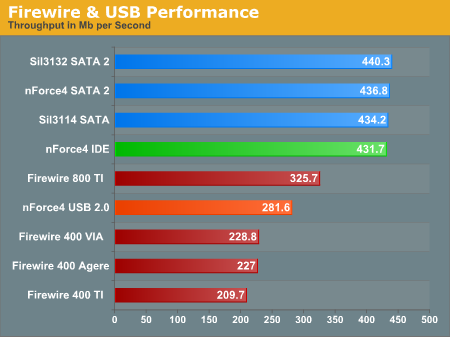nForce4 Ultra Roundup: Charting the Mainstream
by Wesley Fink on July 5, 2005 10:28 PM EST- Posted in
- Motherboards
Firewire and USB Performance
It is really difficult to put together a simple, repeatable, and consistent test to measure USB and Firewire Performance. Since our goal was to make this a standard part of motherboard testing, we needed a benchmark that was reasonably simple to run and that would also provide consistent results on the same test bed. We finally determined that an external USB 2.0, Firewire 400, and Firewire 800 hard disk might be a sensible way to look at USB and Firewire throughput.Our first efforts at testing with an IDE or SATA drive as the "server" yielded very inconsistent results, since Windows XP sets up cache schemes to improve performance. Finally, we decided to try a RAM disk as our "server", since memory removed almost all overhead from the serving end. We also managed to turn off disk caching on the USB and Firewire side by setting up the drives for "quick disconnect" and our results were then consistent over many test runs.
We used just 1GB of fast 2-2-2 system memory set up as a 450MB RAM disk and 550MB of system memory. Our stock file was the SPECviewPerf install file, which is 432,533,504 bytes. After copying this file to our RAM disk, we calculated the time for writing from the RAM disk to our external USB 2.0 or Firewire 400 or Firewire 800 drive using a Windows timing program written for AnandTech by our own Jason Clark. The copy times in seconds were then converted into Megabits per second (Mb) to provide a convenient means of comparing throughput. Higher Rates therefore mean better performance.

Our test is just one of many throughput tests, but in this benchmark, it is clear that the VIA Firewire 400 and Agere 400 are faster than TI's 1394a chip.
All of the SATA solutions also slightly outperform IDE in our timed copy from RAM disk. We did not have 3Gb/s drives to test with the onboard NVIDIA SATA 2, but it is still interesting that throughput with a SATA 1 drive is still a bit faster on the SATA 2 controllers than on SATA 1. For more information on SATA 2 3Gb/s performance, please check a recent review under the Storage tab at the top of the page.










75 Comments
View All Comments
vijay333 - Wednesday, July 6, 2005 - link
oh...final system will have 4-5 HDs, standard DVD reader/writer along with (most likely) a 6800Ultra or a X800XL...Xenoterranos - Wednesday, July 6, 2005 - link
Anandtech did toy with a listening test a while back (I really don't remember much about it, other than the fact that they should have used Klipsch proMedia Ultra 5.1 speakers...)vijay333 - Wednesday, July 6, 2005 - link
Maybe I missed this info in the article somehow, but could you provide the minimum/recommended PSU wattages for the motherboards? esp the DFI and the Epox. I have a Antec 400W Smartpower PSU right now, but read a few posts on newegg that this might not be enough? Hope I don't need to upgrade this too along with the mobo, cpu and gpu...vijay333 - Wednesday, July 6, 2005 - link
knitecrow - Wednesday, July 6, 2005 - link
I have a comment about audio -- a topic that most sites ignore.Shouldn't there be a blind listening test?
i mean cpu utilization is fairly useless. If i am listening to mp3s i care more about the quality than cpu utilization.
flatblastard - Wednesday, July 6, 2005 - link
I stopped reading on page 4 upon discovering the round-up. No explanation needed...Wesley Fink - Wednesday, July 6, 2005 - link
g33k -The DFI was more a control to demonstrate SLI and Ultra performance were the same other than SLI video. Drivers have updated and we retested everything on the DFI as a sanity check. We ran benchmarks and not a full review, but it was hard to ignore the excellent performance.
There is also a comment in our Final Words that the MSI Ultra board should also be considered a winner, since the SLI version was a Gold Editors Choice in the SLI roundup, and the Ultra should perform the same.
g33k - Tuesday, July 5, 2005 - link
Along the same logic though, I'm curious as to why you chose to review the DFI Ultra-D when you reviewed the SLI version of this board earlier as well?.g33k - Tuesday, July 5, 2005 - link
Jeez, read Wesley's comments, he just answered why he did not review, the MSI board. It was already reviewed in the SLI roundup.Wesley Fink - Tuesday, July 5, 2005 - link
"As you can see, none of the onboard audio solutions were quite as low in CPU utilization as the Creative SoundBlaster Live! Chip, which is used on the MSI K8N Neo4 SLI Platinum tested in the nForce4 SLI roundup."Since this is still nF4 we included components tested on all nForce4 boards. The Ultra version of the MSI, BTW, uses the Realtek ALC850 chipset and not the Sound Blaster Live!. The SB Live! is only used on the MSI SLI.